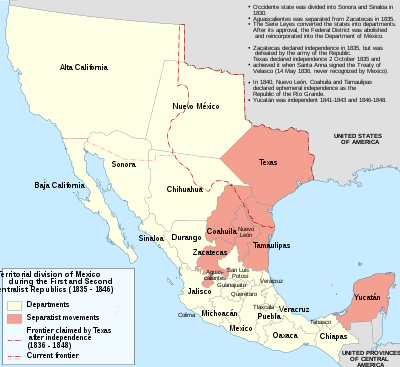Our website is made possible by displaying online advertisements to our visitors.
Please consider supporting us by disabling your ad blocker.
Runaway Scrape

The Runaway Scrape events took place mainly between September 1835 and April 1836 and were the evacuations by Texas residents fleeing the Mexican Army of Operations during the Texas Revolution, from the Battle of the Alamo through the decisive Battle of San Jacinto. The ad interim government of the new Republic of Texas and much of the civilian population fled eastward ahead of the Mexican forces. The conflict arose after Antonio López de Santa Anna abrogated the 1824 Constitution of Mexico and established martial law in Coahuila y Tejas. The Texians resisted and declared their independence. It was Sam Houston's responsibility, as the appointed commander-in-chief of the Provisional Army of Texas (before such an army actually existed), to recruit and train a military force to defend the population against troops led by Santa Anna.
Residents on the Gulf Coast and at San Antonio de Béxar began evacuating in January upon learning of the Mexican army's troop movements into their area, an event that was ultimately replayed across Texas. During early skirmishes, some Texian soldiers surrendered, believing that they would become prisoners of war — but Santa Anna demanded their executions. The news of the Battle of the Alamo and the Goliad massacre instilled fear in the population and resulted in the mass exodus of the civilian population of Gonzales, where the opening battle of the Texian revolution had begun and where, only days before the fall of the Alamo, they had sent a militia to reinforce the defenders at the mission. The civilian refugees were accompanied by the newly forming provisional army, as Houston bought time to train soldiers and create a military structure that could oppose Santa Anna's greater forces. Houston's actions were viewed as cowardice by the ad interim government, as well as by some of his own troops. As he and the refugees from Gonzales escaped first to the Colorado River and then to the Brazos, evacuees from other areas trickled in and new militia groups arrived to join with Houston's force.
The towns of Gonzales, Beason’s Crossing (present day Columbus) and San Felipe de Austin were burned to keep them out of the hands of the Mexican army. Santa Anna was intent on executing members of the Republic's interim government, who fled from Washington-on-the-Brazos to Groce's Landing to Harrisburgh and New Washington. The government officials eventually escaped to Galveston Island, and Santa Anna burned the towns of Harrisburgh and New Washington when he failed to find them. Approximately 5,000 terrified residents of New Washington fled from the Mexican army. After a little over a month of training the troops, Houston reached a crossroads where he ordered some of them to escort the fleeing refugees farther east while he took the main army southeast to engage the Mexican army. The subsequent Battle of San Jacinto resulted in the surrender of Santa Anna and the signing of the Treaties of Velasco.
Previous Page Next Page


